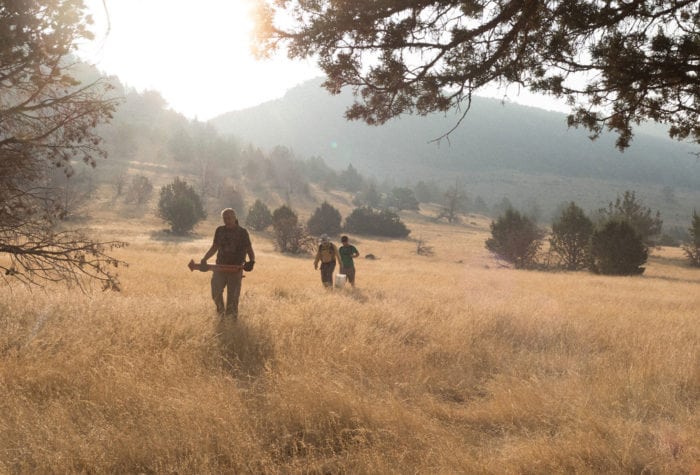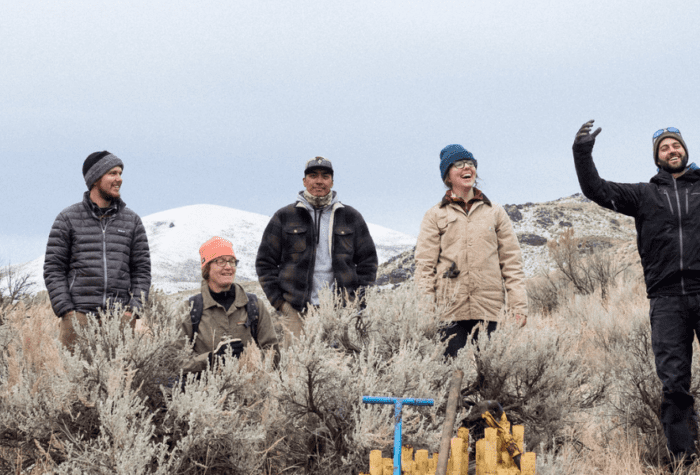Hiking in the high desert presents unique rewards … and unique challenges! Travel safely and responsibly along the Oregon Desert Trail with these tips, principles and essentials.
Desert Travel Tips
Jeremy Fox
Carry a sun umbrella. There can be little to no shade in many places in Oregon’s high desert so consider taking your shade along with you.
Carry tall gaiters. If you are hiking cross-country through heavy vegetation, or in a few spots on the Oregon Desert Trail with difficult bushwhacks, tall gaiters can also provide a peace of mind when traveling through tall grasses that may be hiding rattlesnakes.
Use a hiking pole or stick. Rustle tall grasses as you hike to help alert any snakes or wildlife to your presence and give both of you a chance to move away from an encounter. Hiking poles are also useful when climbing or descending steep terrain, and some ultralight backpacking shelters can be set up with a hiking pole too, negating the need to carry tent poles.
Carry plenty of water. Eastern Oregon is very arid, and you may need more water than you are used to in other environments. Be conservative and carry more than you need until you have a good handle on your body’s needs in this environment.
Consume plenty of electrolytes. Your body needs salts and sugars to help you absorb the water you are drinking. Drink mixes can be a good form of electrolytes, and can also help mask the flavor of the dirtier water sources in the desert.
Carry an adequate water purification system. Water filters are recommended on the Oregon Desert Trail, as well as a way to clean that filter. Some water sources can be muddy, and you will most likely need to clean your filter while hiking in the desert. Consider using a bandanna or your shirt as a pre-filter to get any chunks out of your water before filtering to avoid clogging. Chemical or UV water treatments can be useful as well; sometimes hikers may want to treat particularly dirty water in multiple ways.
Hike early or late. Avoiding the heat of the day can help you make your miles; consider getting up early and hiking late. Mid-day can be a good time for a nice long siesta, and a full moon can give you plenty of hiking time at night, especially during those road walk sections.
Hike in the spring or fall. The shoulder seasons in the high desert can provide more comfortable temperatures for hiking.
Use Verizon cell service. Verizon has the best cell service throughout the high desert. The exception is in the Owyhee region where there is little to no service at all.
Consider a personal locater beacon if you are going into the backcountry. Technology has advanced to the point that hikers can always seek assistance if needed with the use of personal locater beacons, such as the Spot, and the inReach Explorer. The benefit to a device like the inReach is the ability to communicate via satellite text messages even while in hard-to-reach places like the Owyhee canyon.
Avoid walking on Cryptobiotic soil crusts. Several places along the Oregon Desert Trail, including the Lost Forest, have cryptobiotic soil crusts. These soil types perform important ecological roles including carbon fixation, nitrogen fixation, soil stabilization, alter soil albedo and water relations, and affect germination and nutrient levels in vascular plants. They look like black, knobby crusts on the soil or sand and should not be disturbed.
Don’t follow footprints. The Oregon Desert Trail has many miles of cross-country travel, and it’s best to think of these sections as a suggestion of travel. Because we want to minimize impacts of travel in these landscapes, if you see other footprints, don’t follow them. Instead choose a similar bearing and walk a short distance away. Desert soils can be easily impacted, and it only takes a few hikers to start establishing tread in the desert. Use this opportunity to explore: climb a mountain or hike through a nearby valley…make the route unique to your trip, but make sure to stay on public land. Private land is marked clearly on the maps.
Cross fences with caution. Hikers will encounter fences on their hike of the Oregon Desert Trail, and yes, fences are on public lands. Because many of the high desert landscapes are used for grazing and ranching, these fences keep the cattle where they belong. Cross these fences with care. If you encounter gates, leave them as you find them. Please respect the multiple other uses throughout in the desert.
Cover up. Desert sun can be harsh on a hiker’s skin, so consider covering up with lightweight long sleeves and pants for sun protection.
Prepare for hot days and cool nights. Even on the hottest days in the desert, the temperatures can drop dramatically when the sun sets.
Avoid driving on wet roads. Waterlogged desert soils can bog down a vehicle in inches or feet of mud. If you are traveling to a remote part of the Oregon Desert Trail, recent precipitation could make some roads impassable, even on flat terrain. Gravel roads can be a better bet when conditions are wet as the gravel can provide extra traction between your car tires and the slick mud. Help in the form of a tow-truck can be hours to days away, and prohibitively expensive in these remote locations.
Pace yourself. Many factors could impact your daily mileage on the Oregon Desert Trail, so it is a good idea to be conservative in your abilities at first. The route is unmarked, and contains over 30 percent cross-country travel; these factors can significantly impact your usual pace.
Share your hiking plans. Hiking solo or with a small group can be safe and enjoyable if you are prepared, and part of that includes sharing your travel/hiking plans with someone and checking in from time to time. Oregon Desert Trail trail registers are also available in certain places along the route (primarily in trail town businesses; see the Town & Services Guide for more info on their location).
Travel responsibly in the Oregon desert and please follow the seven Leave No Trace Principles
Plan Ahead and Prepare
Know the regulations and special concerns for the area you’ll visit.
Prepare for extreme weather, hazards, and emergencies.
Schedule your trip to avoid times of high use.
Visit in small groups when possible. Consider splitting larger groups into smaller groups.
Repackage food to minimize waste.
Use a map and compass to eliminate the use of marking paint, rock cairns or flagging.
Travel and Camp on Durable Surfaces
Durable surfaces include established trails and campsites, rock, gravel, dry grasses or snow.
Protect riparian areas by camping at least 200 feet from lakes and streams.
Good campsites are found, not made. Altering a site is not necessary.
In popular areas:
Concentrate use on existing trails and campsites.
Walk single file in the middle of the trail, even when wet or muddy.
Keep campsites small. Focus activity in areas where vegetation is absent.
In pristine areas:
Disperse use to prevent the creation of campsites and trails.
Avoid places where impacts are just beginning.
Dispose of Waste Properly
Pack it in, pack it out. Inspect your campsite and rest areas for trash or spilled foods. Pack out all trash, leftover food and litter.
Deposit solid human waste in cat holes dug 6 to 8 inches deep, at least 200 feet from water, camp and trails. Cover and disguise the cat hole when finished.
Pack out toilet paper and hygiene products.
To wash yourself or your dishes, carry water 200 feet away from streams or lakes and use small amounts of biodegradable soap. Scatter strained dishwater.
Leave What You Find
Preserve the past: examine, but do not touch cultural or historic structures and artifacts.
Leave rocks, plants and other natural objects as you find them.
Avoid introducing or transporting non-native species.
Do not build structures, furniture, or dig trenches.
Minimize Campfire Impacts
Campfires can cause lasting impacts to the backcountry. Use a lightweight stove for cooking and enjoy a candle lantern for light.
Where fires are permitted, use established fire rings, fire pans, or mound fires.
Keep fires small. Only use sticks from the ground that can be broken by hand.
Burn all wood and coals to ash, put out campfires completely, then scatter cool ashes.
Respect Wildlife
Observe wildlife from a distance. Do not follow or approach them.
Never feed animals. Feeding wildlife damages their health, alters natural behaviors, and exposes them to predators and other dangers.
Protect wildlife and your food by storing rations and trash securely.
Control pets at all times, or leave them at home.
Avoid wildlife during sensitive times: mating, nesting, raising young, or winter.
Be Considerate of Other Visitors
Respect other visitors and protect the quality of their experience.
Be courteous. Yield to other users on the trail.
Step to the downhill side of the trail when encountering pack stock.
Take breaks and camp away from trails and other visitors.
Let nature’s sounds prevail. Avoid loud voices and noises.
The point of the Ten Essentials list, originally developed by The Mountaineers, has always been to help answer two basic questions: First, can you respond positively to an accident or emergency? Second, can you safely spend a night—or more—out? The list evolved over time from a list of individual items to a list of functional systems.
TEN ESSENTIAL SYSTEMS
Navigation (map & compass)
Sun protection (sunglasses & sunscreen)
Insulation (extra clothing)
Illumination (headlamp/flashlight)
First-aid supplies
Fire (waterproof matches/lighter/candle)
Repair kit and tools
Nutrition (extra food)
Hydration (extra water)
Emergency shelter (tent/plastic tube tent/garbage bag)
–Adapted from Mountaineering: Freedom of the Hills, published by Mountaineers Books

